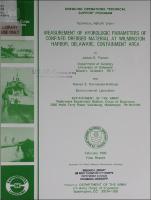Please use this identifier to cite or link to this item:
https://hdl.handle.net/11681/4634| Title: | Measurement of hydrologic parameters of confined dredged material at Wilmingaton Harbor, Delaware, containment area |
| Authors: | Pizzuto, James E. Poindexter-Rollings, Marian E. |
| Keywords: | Dredged material Hydrology Disposal Dewatering Parameters Desiccation Soft soil Dredging spoil Computer programs Primary Consolidation and Desiccation of Dredged Fill (PCDDF) Wilmington (Del.) Dredging Operations Technical Support Program (U.S.) |
| Publisher: | U.S. Army Engineer Waterways Experiment Station |
| Series/Report no.: | Technical Report (Dredging Operations Technical Support Program (U.S.)) ; no.Technical Report D-90-4 |
| Abstract: | A computer model, Primary Consolidation and Desiccation of Dredged Fill (PCDDF), has been developed to predict the settlement of dredged material placed in confined disposal sites. PCDDF, a model that calculates both consolidation settlement and desiccation settlement, uses a well established theory to predict consolidation and employs an empirical formulation to predict desiccation. At present, no field or laboratory procedures exist for determining values for the empirical desiccation parameters. This study established procedures for quantifying these parameters through a field evaluation program in the US Army Engineer District, Philadelphia. A water budget approach was used to calculate desiccation parameters for the dried crust of the desiccating dredged material at the Wilmington Harbor Containment Area near Wilmington, DE. The evaporation efficiency was found to be a constant value of 0.72, the drainage efficiency was 0.21, the saturation limit was 3.02, the desiccation limit was 2.69, the depth of second-stage drying was 0.20 m, and the percent saturation of the desiccated crust (including cracks) was 0.74. The long-term water budget for the desiccated crust for the entire duration of the study clearly indicates that second-stage drying was largely completed when the study began. Because the study was initiated approximately 1 month after the dredged material was placed, these results suggest that both first- and second-stage drying are completed very rapidly at the Wilmington Harbor Containment Area. The procedures utilized in the study at the Wilmington Harbor containment area can be employed at other dredged material disposal sites to determine quantitative values for the empirical desiccation parameters. |
| Description: | Technical Report |
| Gov't Doc #: | Technical Report D-90-4 |
| Rights: | Approved for public release; distribution is unlimited |
| URI: | http://hdl.handle.net/11681/4634 |
| Appears in Collections: | Technical Report |
Files in This Item:
| File | Description | Size | Format | |
|---|---|---|---|---|
| TR-D-90-4.pdf | Technical Report D-90-4 | 8.45 MB | Adobe PDF |  View/Open |